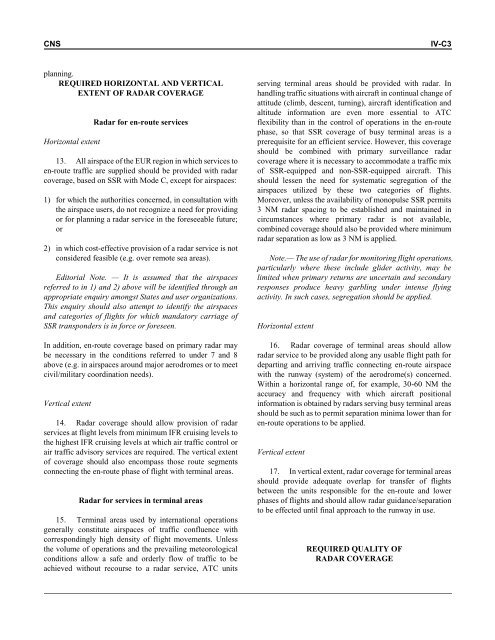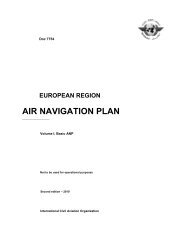7754 Vol 2 Flyleaf - ICAO Public Maps
7754 Vol 2 Flyleaf - ICAO Public Maps
7754 Vol 2 Flyleaf - ICAO Public Maps
You also want an ePaper? Increase the reach of your titles
YUMPU automatically turns print PDFs into web optimized ePapers that Google loves.
CNS<br />
IV-C3<br />
planning.<br />
REQUIRED HORIZONTAL AND VERTICAL<br />
EXTENT OF RADAR COVERAGE<br />
Horizontal extent<br />
Radar for en-route services<br />
13. All airspace of the EUR region in which services to<br />
en-route traffic are supplied should be provided with radar<br />
coverage, based on SSR with Mode C, except for airspaces:<br />
1) for which the authorities concerned, in consultation with<br />
the airspace users, do not recognize a need for providing<br />
or for planning a radar service in the foreseeable future;<br />
or<br />
2) in which cost-effective provision of a radar service is not<br />
considered feasible (e.g. over remote sea areas).<br />
Editorial Note. — It is assumed that the airspaces<br />
referred to in 1) and 2) above will be identified through an<br />
appropriate enquiry amongst States and user organizations.<br />
This enquiry should also attempt to identify the airspaces<br />
and categories of flights for which mandatory carriage of<br />
SSR transponders is in force or foreseen.<br />
In addition, en-route coverage based on primary radar may<br />
be necessary in the conditions referred to under 7 and 8<br />
above (e.g. in airspaces around major aerodromes or to meet<br />
civil/military coordination needs).<br />
Vertical extent<br />
14. Radar coverage should allow provision of radar<br />
services at flight levels from minimum IFR cruising levels to<br />
the highest IFR cruising levels at which air traffic control or<br />
air traffic advisory services are required. The vertical extent<br />
of coverage should also encompass those route segments<br />
connecting the en-route phase of flight with terminal areas.<br />
Radar for services in terminal areas<br />
15. Terminal areas used by international operations<br />
generally constitute airspaces of traffic confluence with<br />
correspondingly high density of flight movements. Unless<br />
the volume of operations and the prevailing meteorological<br />
conditions allow a safe and orderly flow of traffic to be<br />
achieved without recourse to a radar service, ATC units<br />
serving terminal areas should be provided with radar. In<br />
handling traffic situations with aircraft in continual change of<br />
attitude (climb, descent, turning), aircraft identification and<br />
altitude information are even more essential to ATC<br />
flexibility than in the control of operations in the en-route<br />
phase, so that SSR coverage of busy terminal areas is a<br />
prerequisite for an efficient service. However, this coverage<br />
should be combined with primary surveillance radar<br />
coverage where it is necessary to accommodate a traffic mix<br />
of SSR-equipped and non-SSR-equipped aircraft. This<br />
should lessen the need for systematic segregation of the<br />
airspaces utilized by these two categories of flights.<br />
Moreover, unless the availability of monopulse SSR permits<br />
3 NM radar spacing to be established and maintained in<br />
circumstances where primary radar is not available,<br />
combined coverage should also be provided where minimum<br />
radar separation as low as 3 NM is applied.<br />
Note.— The use of radar for monitoring flight operations,<br />
particularly where these include glider activity, may be<br />
limited when primary returns are uncertain and secondary<br />
responses produce heavy garbling under intense flying<br />
activity. In such cases, segregation should be applied.<br />
Horizontal extent<br />
16. Radar coverage of terminal areas should allow<br />
radar service to be provided along any usable flight path for<br />
departing and arriving traffic connecting en-route airspace<br />
with the runway (system) of the aerodrome(s) concerned.<br />
Within a horizontal range of, for example, 30-60 NM the<br />
accuracy and frequency with which aircraft positional<br />
information is obtained by radars serving busy terminal areas<br />
should be such as to permit separation minima lower than for<br />
en-route operations to be applied.<br />
Vertical extent<br />
17. In vertical extent, radar coverage for terminal areas<br />
should provide adequate overlap for transfer of flights<br />
between the units responsible for the en-route and lower<br />
phases of flights and should allow radar guidance/separation<br />
to be effected until final approach to the runway in use.<br />
REQUIRED QUALITY OF<br />
RADAR COVERAGE














